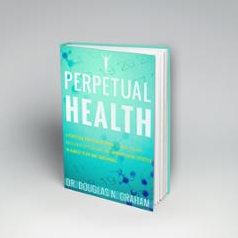|
All Products
|
Fitness & Athletics
|
Food Preparation
|
Emotional / Spiritual
|
Science of 80/10/10
|
|||||
| Retreats | Getting Started with 80/10/10 | Specials | Media Type (books, videos..) | Coaching & Certification |
Perpetual Health 365 *eBook
by Dr. Graham
Would you like to have a world-class coach helping you every day?
Imagine what you can achieve with a Life Coach, a Health Coach, and a Fitness Coach in your head everyday.
The people we admire usually have the advantage of world class information at their finger tips and with this great text available as your companion you can enjoy those same advantages.
Perpetual Health, which acts very much like a year-long course is exceptionally wide-ranging, hitting on all kinds of ways that good nutrition and healthy lifestyles can be easily understood and just as easily implemented.
If you want the motivation, the science, and the occasional good laugh at the sometimes crazy health scene, you have to read Perpetual Health.
The beauty of the book is that it is designed to be read at a pace of just one lesson per day, so the time commitment is short, but the effect Perpetual Health will have on your health will be huge!
Who Is This Book For?
*Anyone who is interested in learning how to best increase their energy levels,
*Athletes who want to sustain longer and better in their sport,
*Anyone who wants to learn how to create a healthy lifestyle,
*Anyone who wants to know how to get fit,
*People that are 'sick' of getting recurring illnesses and want to do something about it,
*Anyone who wishes they had just a little more energy to enjoy life more.
You’ll gain a breadth of knowledge for those who already know and understand how to create abundant health, Perpetual Health 365 serves as a challenge and a tool for everyone to raise the bar, raise expectations, and improve lifestyle in almost every way imaginable.
Perpetual Health is written like a year-long course, to be read one lesson per day for the entire year. Dr. Graham covers a huge variety of topics, as this book is truly his masterpiece work on health. The 378 lessons are each short enough to be read and understood in under 10 minutes, limiting your daily time commitment while making this fairly long book much easier to read.
Perpetual Health is designed to help you bring healthy changes into every aspect of your lifestyle, including the way you think about yourself and the way you talk to yourself. Expect the influence of Dr. Graham’s epic book, the one he wants you to remember him by, to have a profound influence on your life. The best gift you could possibly give yourself and your loved ones is the gift of Perpetual Health.
Dr. Graham holds your hand and guides you along a journey into healthful living.
Perpetual Health is a course in health that you can take one day/one page at a time. I have always appreciated the beauty of perpetual calendars, so why not a perpetual course?
Each day’s lesson explores a single health concept or factor, addresses it in depth, and then moves on. By the time you return to the lesson, a full year later, much of what you read a year ago will either seem new to you again, or be an old friend that you are happy to revisit, expanding your understanding and appreciation for the depth of the message.
What You’ll Get From This Book?
*Learn how to become more fit,
*Learn which foods are providing you with the most energy per bite,
*Learn which supplements work and why most don’t,
*Learn how to effectively lose weight,
*Learn the fundamentals about health production in your body,
*Learn why some people don’t burn fat,
*Learn how to create more health.
Whatever you're looking for - weight loss, more energy, freedom from disease, a total feeling of well-being that you may never have experienced before in your life - you can have it. Make this year YOUR YEAR, with Perpetual Health.
We are including an excerpt for your curiosity and the video above to showcase the range this book offers you.
December 28
The sum of the body’s anabolic and catabolic processes is known as metabolism.
Catabolism is the breaking down or destruction of complex structures into simpler ones. Usually, energy is released as a result of this process. Catabolism occurs in many different ways, at different levels of scale throughout the body. In our digestive tract, catabolism is how we convert large molecules such as polysaccharides, lipids, nucleic acids, and proteins, into smaller structures such as monosaccharides, fatty acids, nucleotides (the building blocks of DNA and RNA,) and amino acids. Most of the catabolic processes that occur within the body are influenced by signals known as catabolic hormones. Discovered in the early 20th century, the classic catabolic hormones include: cortisol, glucagon, and adrenaline (and other catecholamines.)
Cortisol is the principal steroid hormone produced by the adrenal cortex. It plays a role in regulating carbohydrate metabolism and immune responses, and helps maintain blood pressure. When natural or synthetic cortisol is used as a pharmaceutical, it is known as hydrocortisone.
Glucagon is a hormone secreted by the pancreas that helps regulate blood glucose levels by working in opposition to insulin, raising blood glucose levels by stimulating the breakdown of glycogen by the liver.
Adrenaline, also known as epinephrine because it is manufactured near the kidney’s nephrons, (the proper chemical name is: aminohydroxyphenylpropionic acid,) is produced in the medulla of the adrenal glands. Adrenaline is involved in the “flight or fight” response, and helps the liver release glucose into the bloodstream from the breakdown of glycogen.
The energy and fuel released as a result of catabolism is used by the cells to drive the body’s anabolic processes.
Anabolism, sometimes referred to as “constructive metabolism,” is the synthesis in living organisms of complex structures from simpler ones, often resulting in the storage of fuel and/or energy. Anabolism is, essentially, a growth process, resulting in cell differentiation, increases in size, or an increase in cellular concentration (such as an increase in mineral matter within a bone.) All growth and repair processes are anabolic in nature.
Anabolism and catabolism are the yin and yang of metabolism, the components that comprise metabolism. They are opposites, yet each sets the stage for the other. While metabolic rate can be measured, and is defined as fuel use per unit of time, the body has no metabolism of its own, per se. Basal metabolic rate can also be measured, and is defined as the minimal fuel use per unit of time, when at rest. In hygiene, we recognize that even deeper states of rest can be achieved than those typically seen when we are eating and digesting our daily meals, hence we also recognize the existence of a fasting basal metabolic rate, which typically runs ten to fifteen percent lower than ones basal metabolic rate.
|
FAQ
Links Photo Gallery Testimonials Schedule |
Contact
Policies Get Certified Member Login Affiliate Program |
About
Newsletter Recipes Free Videos Forum |
Share 80/10/10
|
|
© FoodnSport
|
|||






 1
1 2
2 3
3 4
4 5
5


